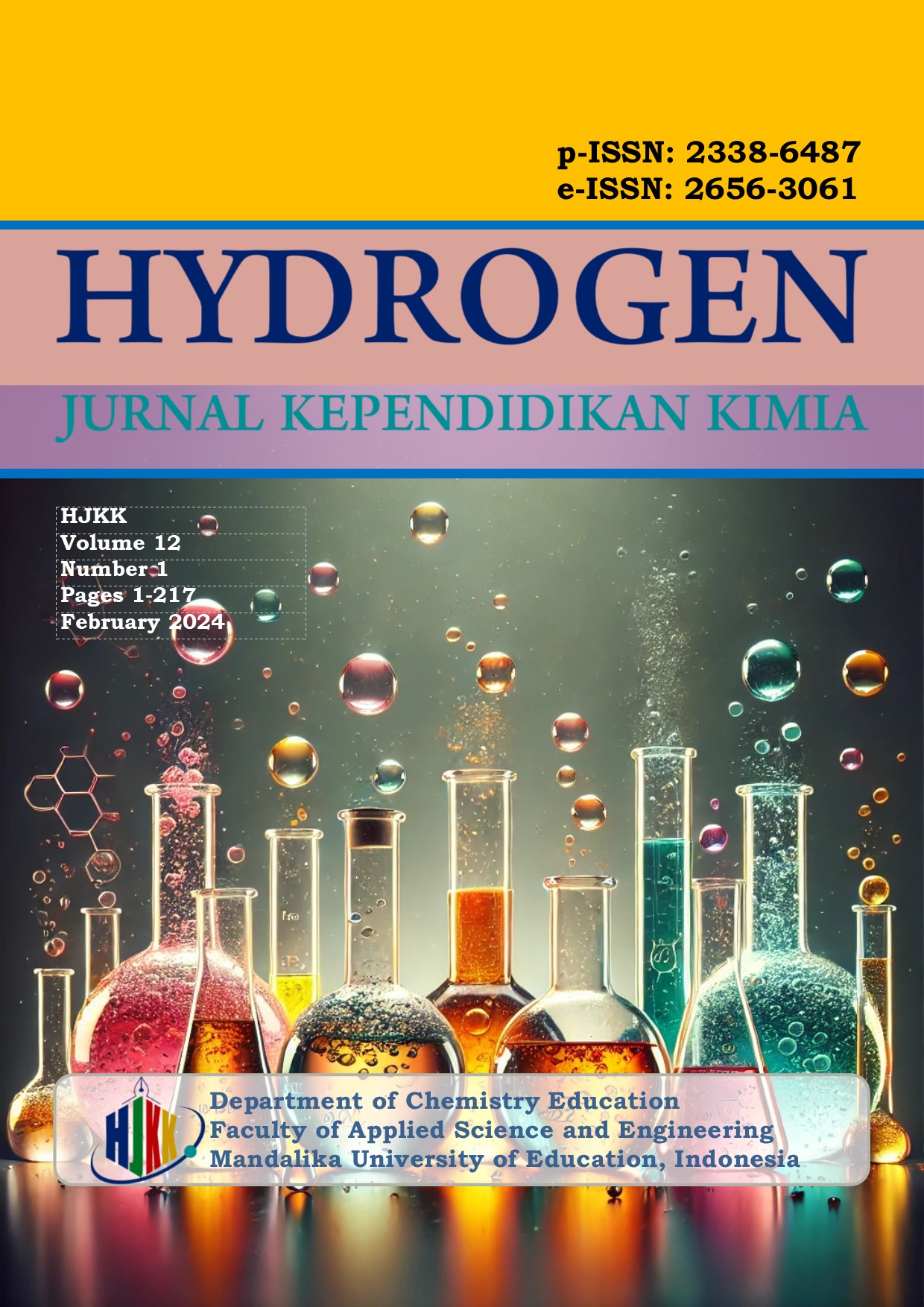Biosynthesis of Gold Nanoparticles Using Wuluh Star Fruit (Averrhoa bilimbi) for Chromium Analysis
DOI:
https://doi.org/10.33394/hjkk.v12i1.10188Keywords:
Kromium, Nanopartikel Emas, Belimbing Wuluh, KolorimetriAbstract
One of the heavy metals that can pollute waters is the heavy metal chromium (Cr). Chromium has many important roles in life. Chromium material is widely used by humans for various purposes, especially in the industrial world. However, the large number of uses of chromium in the industrial world and the waste it generates can have a negative impact on the environment and human health. One way to deal with chromium pollution is by analyzing the presence of chromium in waters. The aim of this research is to analyze the presence of chromium using a simple, effective, economical and accurate method, namely the biosynthesis of gold nanoparticles using samples of starfruit (Averrhoa bilimbi) as a bioreductor rich in ascorbic acid, with a colorimetric method, namely a method based on the aggregation of gold nanoparticles with ascorbic acid from starfruit, which causes a shift in plasmons and causes color changes that can be seen by the eye. Based on the analysis results, data was obtained that gold nanoparticles synthesized from the starfruit bioreductor can detect chromium with a concentration of 10 ppm with optimum conditions at pH 5, temperature 75oC, optimum incubation time of 5 minutes and gold nanoparticles are selective and sensitive for detecting chromium.
References
Abdullah, M., Yudistira, V., Nirmin., dan Khairurrijal. (2008). Review: Sintesis Nanomaterial. Jurnal Nanosains & Nanoteknologi. 2(1): 33-57.
Agustina, T., & Teknik, F. (2014). Kontaminasi Logam Berat Pada Makanan Dan Dampaknya Pada Kesehatan. Teknobuga, 1(1), 53–65.
Amiruddin, M. A., & Taufikurrohmah, T. (2013). Material Peredam Radikal Synthesis and Characterization of Gold Nanoparticle Using a Matrix of Bentonite in Scavenging Free Radicals in Cosmetics. UNESA Journal of Chemistry Vol. 2, No. 1, January 2013, 2(1), 68–75.
Amourizi, F., Dashtian, K., & Ghaedi, M. (2020). Polyvinylalcohol-citrate-stabilized gold nanoparticles supported congo red indicator as an optical sensor for selective colorimetric determination of Cr(III) ion. Polyhedron, 176(February 2022), 114278. https://doi.org/10.1016/j.poly.2019.114278
Azhar, F. F. (2019). Pemanfaatan Nanopartikel Perak Ekstrak Belimbing Wuluh Sebagai Indikator Kolorimetri Logam Merkuri. Jurnal Ipteks Terapan, 13(1), 34. https://doi.org/10.22216/jit.2019.v13i1.3614
Hitsmi, M., Firdaus, M. L., & Nurhamidah, N. (2019). Pengembangan Metode Citra Digital Berbasis Aplikasi Android Untuk Analisis Ion Logam Cr(VI). Alotrop, 2(2), 117–124. https://doi.org/10.33369/atp.v4i2.13835
Hua Lo, S., Chun Wu Ming, Venkatesan Parthiban dan Pao Wu Shu, (2015). Colorimetric Detection of Chromium(III) using O-phospo- L-serine dithiocarbamic acid Functionalized Gold Nanoparticles.Sensors and Actuators B: Chemical. 220 : 772-778
Kumar, B., & Cumbal, L. (2016). UV-Vis , FTIR and antioxidant study of Persea Americana ( Avocado ) leaf and fruit : A comparison UV-Vis , FTIR y estudio antioxidante de Persea Americana hoja y fruto ( Avocado ): Una comparaci ´ on. 13–20.
Li, S., Wei, T., Ren, G., Chai, F., Wu, H., & Qu, F. (2017). Gold nanoparticles based colorimetric probe for Cr(III) and Cr(VI) detection. Colloids and Surfaces A: Physicochemical and Engineering Aspects, 535(Iii), 215–224. https://doi.org/10.1016/j.colsurfa.2017.09.028
Palar, H. 2008. Pencemaran dan Toksikologi Logam Berat. Jakarta: Rineka Cipta
Riyanto. 2014. Verifikasi dan Validasi. Yogyakarta: Deepublish.
Schiavon, M., Pilonâ€Smits, E. A. H., Wirtz, M., Hell, R., & Malagoli, M. (2008). Interactions between Chromium and Sulfur Metabolism in Brassica juncea . Journal of Environmental Quality, 37(4), 1536–1545. https://doi.org/10.2134/jeq2007.0032
Suprapti, N. H. (2012). Kandungan Chromium pada Perairan, Sedimen dan Kerang Darah (Anadara granosa) di Wilayah Pantai Sekitar Muara Sungai Sayung Desa Morosari Kabupaten Demak, Jawa Tengah. Bioma : Berkala Ilmiah Biologi, 10(2), 36. https://doi.org/10.14710/bioma.10.2.36-40
Thakkar, K. N., Mhatre, S. S., & Parikh, R. Y. (2010). Biological synthesis of metallic nanoparticles. Nanomedicine: Nanotechnology, Biology, and Medicine, 6(2), 257–262. https://doi.org/10.1016/j.nano.2009.07.002
Downloads
Published
How to Cite
Issue
Section
Citation Check
License
License and Publishing Agreement
In submitting the manuscript to the journal, the authors certify that:
- They are authorized by their co-authors to enter into these arrangements.
- The work described has not been formally published before, except in the form of an abstract or as part of a published lecture, review, thesis, or overlay journal.
- That it is not under consideration for publication elsewhere,
- That its publication has been approved by all the author(s) and by the responsible authorities – tacitly or explicitly – of the institutes where the work has been carried out.
- They secure the right to reproduce any material that has already been published or copyrighted elsewhere.
- They agree to the following license and publishing agreement.
Copyright
Authors who publish with Hydrogen: Jurnal Kependidikan Kimia agree to the following terms:
- Authors retain copyright and grant the journal right of first publication with the work simultaneously licensed under a Creative Commons Attribution License (CC BY-SA 4.0) that allows others to share the work with an acknowledgment of the work's authorship and initial publication in this journal.Â
- Authors are able to enter into separate, additional contractual arrangements for the non-exclusive distribution of the journal's published version of the work (e.g., post it to an institutional repository or publish it in a book), with an acknowledgment of its initial publication in this journal.
- Authors are permitted and encouraged to post their work online (e.g., in institutional repositories or on their website) prior to and during the submission process, as it can lead to productive exchanges, as well as earlier and greater citation of published work.
Licensing for Data Publication
Hydrogen: Jurnal Kependidikan Kimia uses a variety of waivers and licenses, that are specifically designed for and appropriate for the treatment of data: Open Data Commons Attribution License, http://www.opendatacommons.org/licenses/by/1.0/ (default) Other data publishing licenses may be allowed as exceptions (subject to approval by the editor on a case-by-case basis) and should be justified with a written statement from the author, which will be published with the article.







